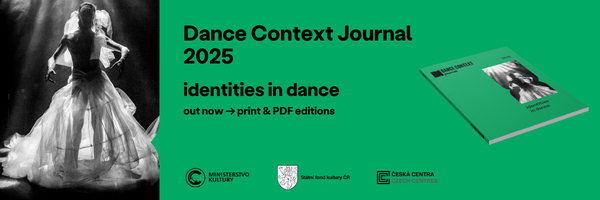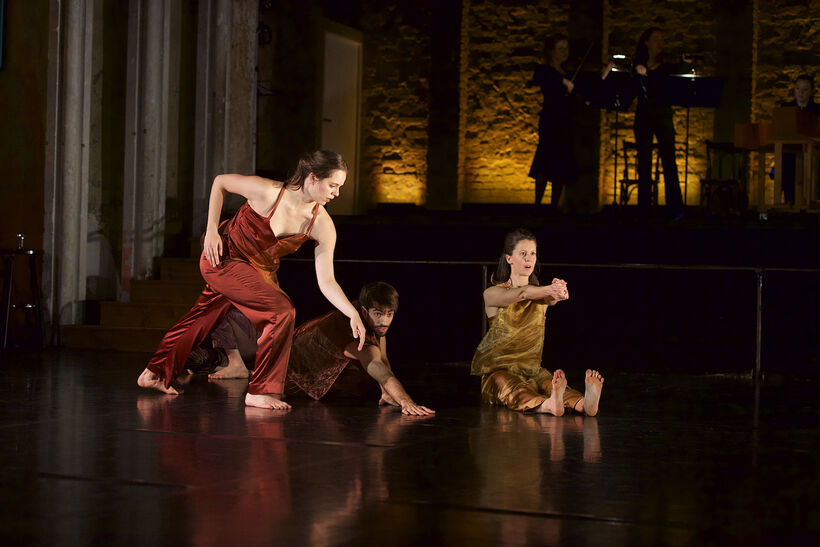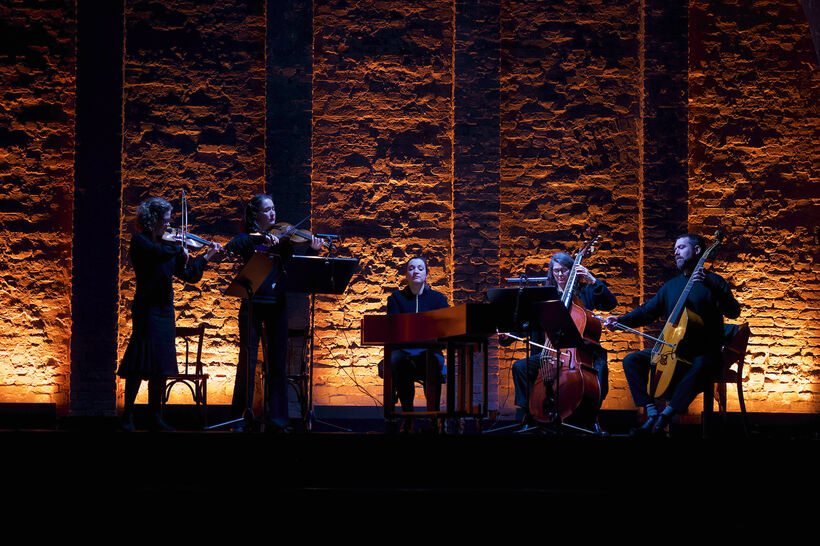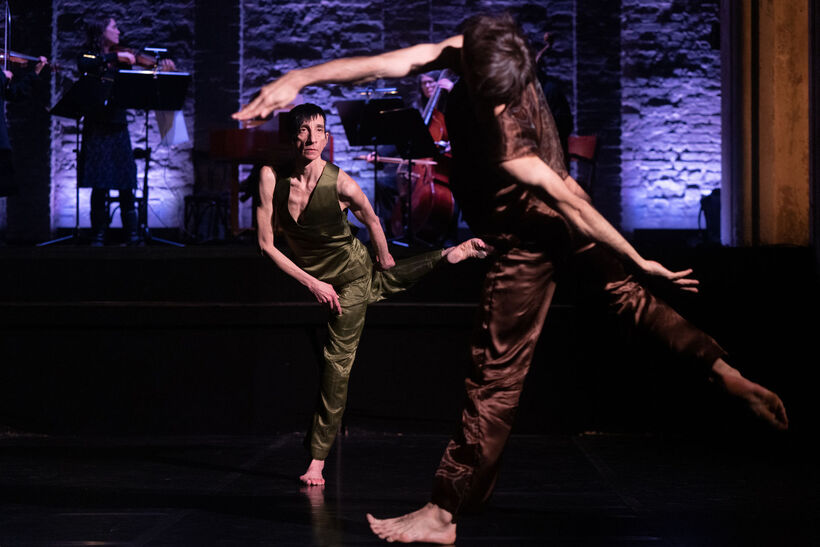Das Fest – A Kinaesthetic Celebration
At the end of November, Berliner dance collective laborgras together with ensemble Continuum presented Das Fest to a sold-out Theater im Delphi, a dance piece bringing contemporary dance and Baroque music together. Initially designed for the stage in 2020, due to pandemic restrictions it was reworked as an online dance concert film in 2021. After two lockdown winters, Das Fest will appear for the first time on stage and with an almost completely different cast, a sign of hope and togetherness in these turbulent times.
As in a baroque festivity, everything is carefully designed, from the costumes and music to the order of the dances, to highlight the greatness of the extraordinary. Das Fest offers an evening where minute attention to detail and the unique environment are intrinsic elements.
Theatre im Delphi – founded in 1929 for silent cinema – is characterised by a particular atmosphere, where the main room structure takes us back in time, from its three large arches surrounding the proscenium to the design of the furniture.
Accompanied by excellent complimentary Chardonnay and snacks, I take my seat and realise that the dancers and musicians are already in the room, warming up and tuning their instruments.
The audience, the dancers, and the musicians are sharing the same space even before the official beginning, the sound of the instruments and the audience’s murmurings merge together. Thus, Das Fest (‘the celebration' in German) has, in a way, already begun.
The performative space is set out as a composed scene. It is a big hall with a bar on one side and a raised stage on the other, where the musicians are located. In front of the bar are some tables and chairs and then, extended into the hall, just in front of the raised stage, an empty space is used as a dance stage. Moreover, there is a balcony with a couple of rows of seats. During the warmup, the dancers and musicians are spread across these multiple action spaces, from the raised stage and dance space, to the bar and balcony. When the performance begins, it mainly takes place in two connected but separate spaces: the musicians on the raised stage and the dancers in the space below.
The dance piece begins in a low light, with a solo (Abraham Iglesias Rodriguez) performed in silence, his gestures guided by his breath. A second dancer (Sara Koluchova) enters and the solo turns into a duet. It is with the next quartet that the music begins, as if it were the dance score that started the music.
laborgras’ unique choreographic design, through Renate Graziadei’s choreographic signature and the dramaturgy by Arthur Stäldi, is both rigorous, mathematical and at the same time intense, thanks to the soft sharpness of the movement language. Shifting weight, movement out of balance, released body dynamics, bodies interweaving, port de bras engraved in the air. Through their extremely fast movements, both calm and precise at the same time, the five dancers beautifully support a choreographic score that is written perfectly for the music. Informed by the movement language of postmodern American choreographers, and with some references to Baroque court dance, the dancers’ bodies are not only released into space, but they also seem to prolong the moment in time, leaning on the air as if it solidified. Through their corporeality they compose a gestural score, applying sudden hand movements, changes of direction, and unexpected smiles to each other. The gestures transcend the stage and reach us – the audience. The choreographic writing generates an accumulation of forms that are composed and decomposed, through highly remarkable body awareness that makes the movements so fresh that sometimes they may even feel sudden, as if created in the moment. Their corporeality impressed on me a very powerful desire for movement.
Interestingly, there are moments where there is no dance, only music. In this time of visual rest from the dance, my eyes can wander across the spatial and physical details of the building and costumes.
Quartets, duets, quintets, and solos interchange. A solo (Arianna Rodeghiero) is located off-stage, close to the audience. I find it intriguing both from a spatial point of view − increasing the distance between the dancer and the accompanying violin − and from a movement language perspective − in the way the dancer moves her gaze and transmits the movements at every point of her body. In another solo (Sergey Zhukov), the feeling of a celebration becomes a lost memory, emerging from fragility, where the light gives space to shadow and the choreography is decomposed. Graziadei's solo, characterised by cold pink and almost grey lights, represents a moment of intense lyricism in embracing the limits of the surrounding space.
laborgras creates an aesthetic experience, not imposing anything on the viewers but leaving them open to perceive multiple impressions. In this way, the dance piece, detached from any conceptualisations per se, goes back to the materiality of bodies, triggers the sensory experience, and evokes our emotions.
The ensemble Continuum offers an exquisite collaboration, and their physical playfulness strikes a good balance with the dance. The choice of Baroque music − Corelli’s, Handel’s, and Torelli’s musical scores − reveals a deep appeal to contemporary audiences and is an ideal source for this dance piece, because of its mathematical structure and its possibilities for composition and recomposition.
Even though a sense of beauty resides in the total accordance of the piece − warm lights designed by Emma Juliard that highlight the architecture of the space, the elegant costumes by Claudia Janitschek, and the artistic collaboration of Barbara Wiegel − it is the details oft this dance piece that will live long in the memory.
In a palette of green, brown, and yellow, created with clever cuts, asymmetries, and weaves on the back, the costumes are efficiently designed for movement. Nevertheless, in their apparent simplicity, their fabric produces a luminous, almost shining effect since they refract the lights, referencing a Baroque festive sensation. This is probably also an accurate historical stylistic choice as the reflectiveness of the fabrics was a relevant issue on a17th and 18th century candle-lit stage.
In Das Fest it all happens right there, on stage, with no narrative elements and no props. However, the effect that emerges is fascinating and immersive, creating a sense of togetherness with the audience to such an extent that I got the impression that the spectators – at least myself – were breathing in unison with the dancers and musicians. The public reception was active and warm. The choreographic vocabulary is generated via the activation of multiple spatial tensions repeated through sets of movements, from which each dancer’s personality emerges, going far beyond pure technique.
In my view, the laborgras’ creative operation is interesting in many respects.
Firstly, the clear, precise, organic connection between the dance and music to the point that sometimes we do not know what comes first. Besides, there is also a visual-numerical relationship: on stage there are five dancers and five musicians. Moreover, the overall capacity to enter into a connection with the Baroque festive spirits (such as the interlacing of the movement sequences, the costumes etc) but reconfigured for our present time.
Secondly, Graziadei, with the dancers’ collaboration, composes movement phrases capable of being broken down and then regenerated in suspended and new points. They create a unique and readable movement vocabulary. In the abstract, with a myriad of balanced (and ironic) gestures, hands, hips, and soft kicks into the air are expressly released into space. As previously mentioned, in a drawing accurate to the millimetre, sometimes I don’t know if they are improvising, so much is carefully intentional, the dancers are with us and dance for us. Graziadei, together with Stäldi, create eloquent bodies capable of bringing out their personalities within a choreographically organised context. Furthermore, the ability of the dance to work on your subconscious: the kinetic and empathic capacity that this language recreates in the viewer’s body, as a ‘listening’ exercise, where everyone is welcome to formulate their own visual path.
Devised as a dance concert, Das Fest is a dance piece where the sense of a celebration is not achieved by stereotyping but by creating a ‘party spirit’. At present I am writing about a celebration that happened, but physically participating in it is quite different. laborgras conceived a party as a stimulation of the aesthetic and physical senses when taking part in it. As in a ritual, our memory is activated and our kinaesthetic sense is stirred up: for instance, when leaving Theater im Delphi I felt like I was lighter on my feet, that my vertebral column was elongated, and that I could savour that moment intensely.
To conclude, I warmly invite you to go and attend Das Fest at the next available opportunity.
Written from the 24th November 2022 premiere at Theater im Delphi (Berlin).
Das Fest
Artistic Direction: laborgras (Renate Graziadei & Arthur Stäldi)
Artistic Collaboration: Barbara Weigel
Choreography: laborgras in collaboration with the dancers Arianna Rodeghiero, Abraham Iglesias Rodriguez, Sergey Zhukov, Sara Koluchova
Dance: Arianna Rodeghiero, Abraham Iglesias Rodriguez, Sergey Zhukov, Renate Graziadei, Sara Koluchova
Dramaturgy: Arthur Stäldi
Musical Direction: Elina Albach
Music: Ensemble Continuum
Violin: Nadja Zwiener, Rahel Mai
Viola da Gamba: Liam Byrne
Violone: Christine Sticher
Harpsichord: Elina Albach
Technical Direction Stage and Lighting: Emma Juliard
Costume Design: Claudia Janitschek
Production Management: Inge Zysk, Raquel Moreira
Press and Public Relation: k3 berlin – Kontor für Kultur und Kommunikation
Distribution and Communication: Astrid Rostaing
Photography: Phil Dera
Design: Mia Sedding
Pieces by: Arcangelo Corelli, Georg Friedrich Händel, Giuseppe Torelli








